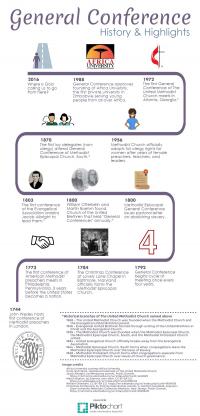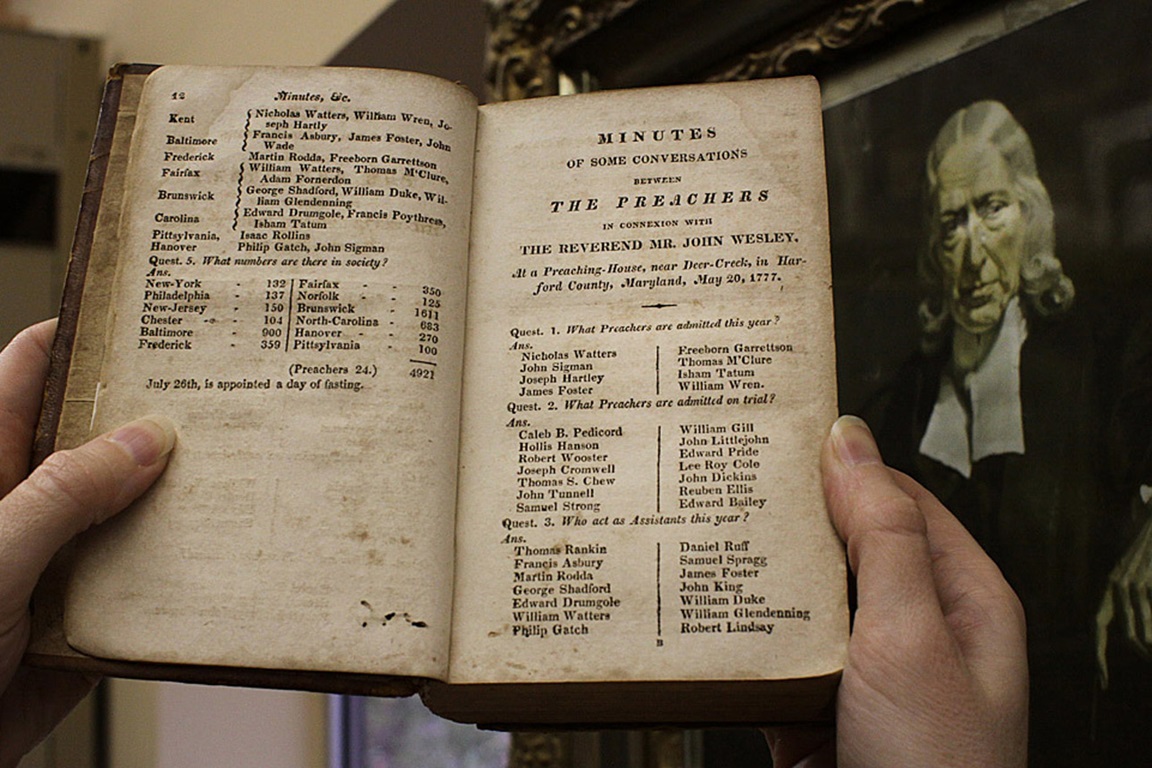Every four years, The United Methodist Church convenes at General Conference. In May 2020, more than 800 delegates elected by their annual conferences—half of them clergy and half laity—will gather in Minneapolis, Minnesota, USA, for the latest conference. They will consider more than 1,000 petitions that will order the work of our churches, pastors and agencies, and set official positions on a variety of subjects.

Conferencing has always been an important part of The United Methodist Church. Click to enlarge. Infographic by United Methodist Communications.
Conferencing is part of our culture as United Methodists. In the earliest days, each of the churches that would join to form The United Methodist Church met in conferences.
OUR HISTORY
John Wesley first called Methodist preachers together in 1744 for a conference in London. When the Methodist movement spread to America, the preachers gathered there for the first time in Philadelphia in 1773.
During the Revolutionary War between England and the American colonies, many Anglican pastors returned home to England, causing a clergy shortage in the new nation. When the Methodists gathered for the Christmas Conference in 1784 at Lovely Lane Chapel in Baltimore, Maryland, they formed a new church, The Methodist Episcopal Church.
The Methodist Episcopal Church preachers would continue to gather in conferences where they published the first Book of Discipline in 1785, and adopted their first constitution in 1808. In 1792, they decided to meet every four years, a practice we continue today!
Shortly after the Christmas Conference, Jacob Albright set out to spread Methodism to the German-speaking people of Pennsylvania. In 1803, those Methodist class meetings met in a conference where they ordained Albright to lead them. In the years that followed, they would name themselves the Evangelical Association, and would continue to hold conferences to lead the new church.
At about the same time, another group of German-speaking Pennsylvanians gathered under the leadership of William Otterbein and Martin Boehm. At their conference in 1800 they ordained bishops and organized themselves into a new church called Church of the United Brethren in Christ, and agreed to meet in annual “General Conferences.” Soon they would also move to a quadrennial (once every four years) cycle.
The Evangelical Association and United Brethren in Christ would form the Evangelical United Brethren in 1946. Then in 1968, they would join with The Methodist Church—formed through a series of splits and unions of The Methodist Episcopal Church—to become The United Methodist Church.
GENERAL CONFERENCE HIGHLIGHTS
Through the years, Methodists have met in General Conferences to make decisions about the life of the church, and to take stands on social issues. Sometimes we have been a leading voice. Other times we have been a bit slower in our decision-making.
Abolishment of slavery: Slavery was a social topic discussed by The Methodist Episcopal Church almost from the very beginning. Many saw the evil of slavery, and a Committee on Slavery reported to General Conference through the early 19th century. At General Conference of 1800, The Methodist Episcopal Church issued a pastoral letter on abolishing slavery, and passed legislation further reinforcing their rules that no Methodist preacher should be a slaveholder or slave trader. Slavery wouldn’t be abolished in the United States until 1865.
Women clergy: Though the church had appointed women to serve as class leaders from the time of John Wesley, and ordained women as early as 1866, it wasn’t until General Conference of 1956 that women received full clergy rights in The Methodist Church. This year’s General Conference will recognize the 60th anniversary of that decision.
Education: In the early 1980s, several United Methodist bishops from Africa dreamed of a university that would educate young people from all over Africa. Working with the General Board of Higher Education and Ministry, they brought the idea before the 1988 General Conference where it was overwhelmingly accepted, and Africa University (AU) was established. AU, the first private university in Zimbabwe, has graduated more than 4,000 students.
Global health: The 2008 General Conference showed the commitment of The United Methodist Church to global health with the establishment of Imagine No Malaria. This ministry was formed to be part an international effort to eradicate Malaria. Nearly $75 million have been raised and used to purchase mosquito nets, fund health facilities, train medical providers, and so much more. General Conference 2016 celebrated the culmination of the Imagine No Malaria campaign, even as it continued to work toward improving the health of all the world’s people.
Where is God calling us to go from here?
As we become a more global church with congregations in Africa, Asia, Europe and North America, we continue to discern how God is calling us to be the church in all nations. General Conference 2016 considered legislation to make The Book of Discipline more global, and in 2020 will consider a more global Social Principles. Then in 2024, General Conference of The United Methodist Church will meet in Manila, the capital of the Philippines. This will be the first General Conference to meet outside of the United States.
There will certainly be challenges ahead, but there will also be opportunities to do great ministry across the globe. Through the grace of God, the wisdom of Christ, and the power of the Holy Spirit, General Conferences will continue to lead us into the future.
*Joe Iovino works for UMC.org at United Methodist Communications. Contact him by email or at 615-312-3733.
Dale Patterson of the General Commission on Archives and History provided information for this story and the accompanying infographic, which were originally published at UMC.org on April 26, 2016.

